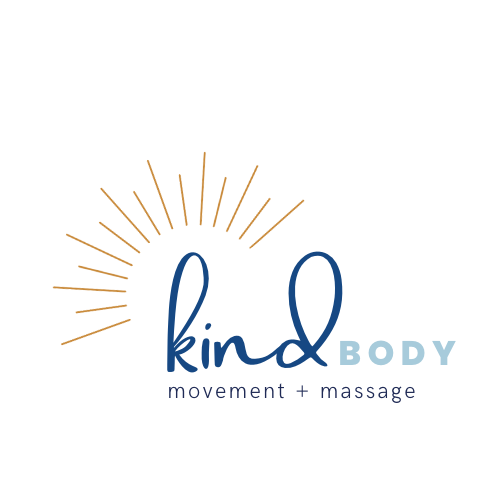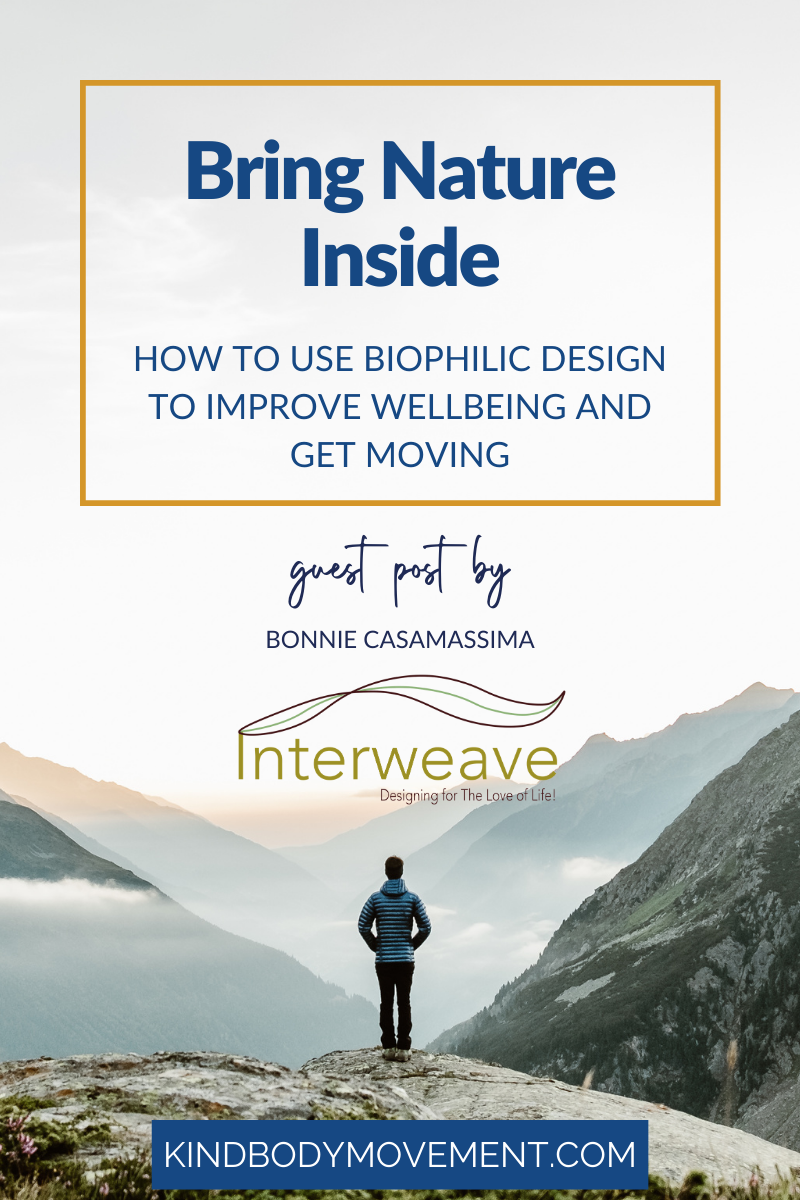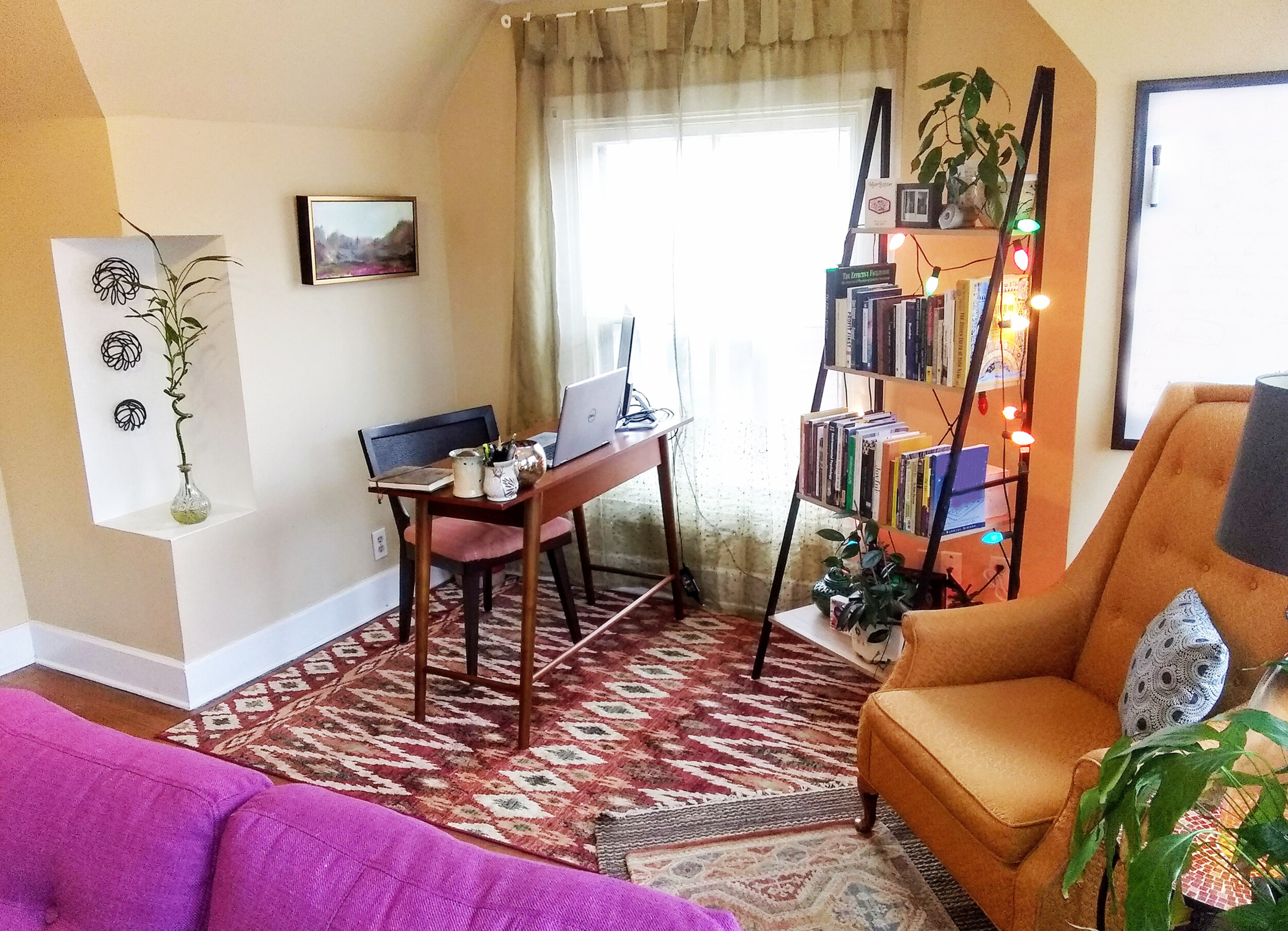How to Bring Nature Inside
How to Use Biophilic Design to Improve Well-being and Get Moving
Now that Spring is here, I’m finding it hard to stay inside. I thrive when I’m outside in the sun and feeling the breeze on my face. While I do intentionally make time to be outside each day, there’s still a large chunk of my time that’s spent inside.
Let’s face it, we spend the majority of our lives inside—nearly 90 percent, in fact. And yet, we know that time spent in nature is good for us. Nature moves our bodies in ways that indoor spaces don’t and can be profoundly healing.
Knowing that we spend so much time indoors, especially for work, how then can we bring nature inside in ways that support our well-being and overall health?
I sat down with interior designer, researcher, and educator, Bonnie Casamassima to get some answers. In our conversation, Bonnie offers low-cost and FREE tips for bringing nature inside in ways that will improve your emotional well-being, get you moving, and even increase your productivity!
J: I didn’t know until hearing you speak that there’s a whole branch of interior design devoted to this concept of bringing nature indoors.
B: Yes! It’s called biophilic design—that basically means we’re letting the science behind the healing connection we have with nature inform the design decisions we make indoors. The spaces we are in can greatly effect our mental and emotional states. Try this: picture you’re in a classroom with bare, white walls and rows of uniform desks, no windows, facing a chalkboard. How do you feel?
J: I feel stressed out! Get me outta there!
B: I know! Just imagining that kind of a space creates a physical response. How did that make your body feel?
J: I could definitely feel some tension creeping in around my neck and shoulders.
B: Exactly. Now, imagine being in your favorite natural space. Maybe you envision sitting by the ocean, hearing crashing waves, or maybe you (like me) remember a time when you climbed to the top of that towering pine tree in your childhood yard and read your favorite book for hours. Regardless of your unique memory, when you imagine being in your favorite natural spot, how do you feel?
J: When I imagine being outside, it makes me take a deep breath!
B: One of the reasons being outside can be so healing or relaxing is that nature engages all of our senses. If we come back to the image of being at the beach we can think of the smell of the salty water, the feeling of the sand on our skin, the sound of the waves—sometimes you can even taste salt in the air! Tuning into our senses brings us into the present moment.
J: That definitely resonates with me. I teach my clients to check-in with their senses as they settle into meditation because it really does take you out of the flurry of thoughts and alerts and lists going off in our brains.
B: And the research backs that up. Research on biophilic design reveals that incorporating natural elements that engage our senses…
• Reduces cortisol levels
• Improves learning
• and Increases social connectivity.
Within the business world, it’s even been shown to positively impact an organization’s financial well-being through increasing focus and productivity.
This quote from Shane Totten sums it up so well:
“When you utilize biophilic design principles in the built environment, you’re fostering a strong sense of connection, sense of order, and sense of safety. Thinking about Maslow’s hierarchy of needs, if you don’t feel safe, you’re not able to aspire to higher levels of well-being. Biophilia allows us to feel safe, supported, and present. With these needs met, we can therefore more easily aspire to the higher levels of well-being, happiness, and achievement.”
J: If there’s one thing I’ve learned as a bodywork professional it’s that the nervous system rules the roost. If the nervous system senses it is safe, marked changes take place in our bodies. So it makes sense to me to prioritize creating a space that cultivates that feeling of safety and invites us to move in helpful ways.
So how can we do this? How can we bring nature inside to engage our senses and to help us feel better, while also prioritizing movement?
B: That’s a great question. Now I know not everyone has the resources to run out and buy a lot of stuff or pay an architect to redesign their home or office—while that would be amazing, I don’t think that’s always necessary. There are certainly simple, cost-effective, and even FREE ways that you can incorporate the science of biophilic design into your spaces. The key with any of these approaches is to ensure you’re engaging all of your senses while celebrating the spirit of the place. Here’s what I recommend:
1. See nature
Windows with a garden view, potted plants, and flowers use our sense of sight to remind us we’re connected to nature. The window is really the best because natural light encourages our circadian processes.
2. Be near water
Have water around that you can see, hear, or touch. This might be a small water feature you place on your desk or even just a soothing white noise machine that plays the sound of running water.
3. Decorate with natural shapes, patterns, colors, and textures
This could be as simple as having a wooden desk and a wicker basket full of blankets. Colors like blue and green tend to be more soothing. The idea here is that all of these things will remind you (whether consciously or unconsciously) that you are connected to nature.
You can also use what’s called an analogous color scheme—it’s the kind of color scheme that’s most often found in nature. Basically, you select two to five colors that are next to each other on the color wheel for use in your spaces. Use colors that you see in nature around the spaces where you live or work to evoke a spirit of place in your design. For example, if you want to evoke the spirit of a desert setting, you would choose different colors than those that would evoke the spirit of a redwood forest.
4. Provide refuge
We’ve already talked about how feeling safe is a really important first step to our well-being—and it’s a step that often takes place without us being consciously aware of it. So if you’re sitting at a desk, it’s ideal to have a solid wall behind you. If a wall isn’t possible, consider a bookshelf, the back of some other furniture, a high-backed chair, or a room dividing screen.
5. Engage your senses
Keep your favorite scented candle on your desk or diffuse an essential oil (lavender is usually calming and peppermint can help energize us and therefore support our ability to focus). If the weather is nice, open the window so you can feel the breeze and hear the birds singing. Consider thick textures for items you touch everyday, such as woodgrain or thick throw-blankets.
J: Those all sound like easy-to-implement ideas. One of the main reasons I’m so interested in bringing nature inside is because nature inspires us to move—something we desperately need to do more of! How can biophilic design help get us moving?
Bonnie’s home office.
B: I’ll start with the home office because that might be where people are spending most of their time. We go through four essential modes of work throughout the day: focus, collaboration, learning, and socialization. That means we should incorporate a variety of spaces or zones in our workplace to accommodate these modes.
For me in my home office, this looks like having a traditional desk and chair for focused work and then a more comfortable chair away from my desk that I use when I’m in learning mode.
J: In my home, I have my floor sitting desk for more focused work and then a variety of cushions and pillows and a stability ball nearby that I like to “play” on when I’m in learning mode—especially while I’m reading.
B: That sounds so fun! I think that when we’re doing more of our focused work, we should pay more attention to our ergonomics. That’s going to help our bodies feel better and boost our productivity. But when we switch into those other modes, we can lounge, stand, or like you, roll! The most important thing, however, is to just keep moving.
You’re the expert on this, so I feel as though I’m singing to the choir leader, but change positions multiple times per day, depending on the work you’re doing—maybe you work at your desk for a bit then move to work while standing at your kitchen island on a conference call. Then sit on a cushion on the floor while reviewing a report or brainstorming new ideas for a project. Changing your posture throughout the day is not only essential for your well-being; it can also help improve happiness and creativity!
Another view of Bonnie’s home office. Notice the high backed chair provides refuge and the layered rugs add texture while defining the space.
J: I’m just remembering my time working in an office. All I had was a cubicle—sure there was a break room for socializing and conference rooms for collaborating—but I spent most of the time in my cubicle, not near a window, not getting to change positions. That was definitely not a good fit for me—it really detracted from my sense of well-being.
B: Yes, I think so many of us have experienced this. Maybe that’s one of the silver linings of the pandemic for those folks who have transitioned to working from home. I know everyone’s experience is different but in many cases, you can just have so much more control over your home office. Thankfully we are seeing many office environments shifting to provide a wider range of space types such as telephone rooms, work cafes, and sit-to-stand desks to support these diverse needs.
And I just want to say again how ideal it is to have a window nearby. Natural light is so so important. If you can, follow the sun through your house or at least think about the time of day when you’re at your best or most productive, and try to be where the sun is shining at that time.
J: That’s certainly another way to keep you moving throughout the day! I instinctively do this—especially in the winter time when I tend to be cold. I’m like a cat looking for a sunny spot to bask in.
B: And that’s the thing with biophilic design—understanding our connection with nature can be intuitively obvious. When we sit down and really think about it, it makes a lot of sense for understanding the importance of pulling the healing abilities of nature into the built spaces of our daily lives—the ones where we spend 90% of our lives! The field of biophilic design helps us understand the research behind those healing benefits and therefore how we can create supportive spaces from it. I’m perhaps most inspired by bringing that research into accessible language so people can apply it in their homes, offices, and other spaces. Thank you for having me for this exciting Q+A!
About Bonnie
Connect with Bonnie if you'd like help making design enhancements to your home, office or other healing environment. Bonnie support projects all the way from a one time 45 minute design session where you can co-create one space using many of your existing items all the way to multi-year large scale development design using the healing science of nature. You can find out more and book a session here. Bonnie is also available for keynote speaking and interviews on how we can connect more deeply with our well-being and intuitive abilities using positive psychology, environmental psychology and biophilic design. You can hop on a 15 minute chat with Bonnie to discuss your needs.
Combining over a decade of research-driven experience, her intuitive empathic nature, and educational approach, Bonnie Casamassima guides clients on how to use the psychology of interior design and the healing science of nature within their everyday spaces to nurture their productivity, intuition, and well-being. She is the Principal and Founder of Interweave People Place and an Adjunct Professor of Interior Design at Savannah College of Art and Design (SCAD).
Bonnie holds a Bachelor of Science degree in Interior Design from the University of Tennessee at Knoxville and a Master of Fine Arts degree with Interior Design focusing on Biophilic Design and Environmental Psychology from SCAD.
She lives in Knoxville, TN with her partner and his two kids. She enjoys traveling, pottery, live-music, and a good belly laugh.









